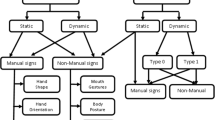Abstract.
In this paper we present a two-dimensional stochastic method for the recognition of unconstrained handwritten words in a small lexicon. The method is based on an efficient combination of hidden Markov models (hmms) and causal Markov random fields (mrfs). It operates in a holistic manner, at the pixel level, on scaled binary word images which are assumed to be random field realizations. The state-related random fields act as smooth local estimators of specific writing strokes by merging conditional pixel probabilities along the columns of the image. The hmm component of our model provides an optimal switching mechanism between sets of mrf distributions in order to dynamically adapt to the features encountered during the left-to-right image scan. Experiments performed on a French omni-scriptor, omni-bank database of handwritten legal check amounts provided by the A2iA company are described in great detail.
Similar content being viewed by others
Author information
Authors and Affiliations
Additional information
Received July 28, 1998 / Revised February 15, 1999
Rights and permissions
About this article
Cite this article
Saon, G. Cursive word recognition using a random field based hidden Markov model. IJDAR 1, 199–208 (1999). https://doi.org/10.1007/s100320050019
Issue Date:
DOI: https://doi.org/10.1007/s100320050019




